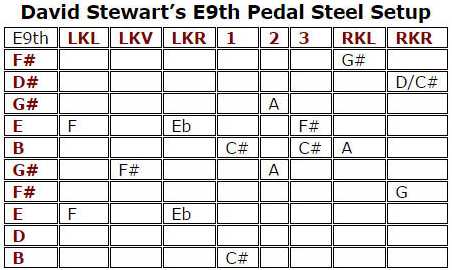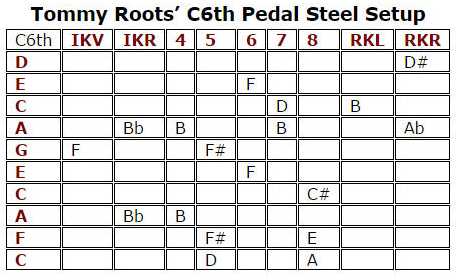
ABOVE: Originally I had a 4th pedal on my S-10 Rittenberry. I removed the 4th pedal with the Paul Franklin change (lowering strings 5, 6 and 10 a whole tone at the same time). I don't care for the Franklin change myself, although I enjoy hearing Paul perform. Tommy splits the change, lowering strings 5 and 6 separately on different knees, which gives you much more versatility. That's what I do.
I much rather prefer Tommy White's method, which is to lower string 5 and 6 separately. Unlike Tommy, I chose not to lower the 10th string a whole tone (it just made the knee too tight to pull). The 4th pedal was getting in the way of pedal 3, when I'd move quickly to press it down, so I removed the 4th pedal. This way I can get a clear shot at the 3rd pedal without trying to avoid pedal 4. I noticed that Lloyd Green's Sho-Bud uses the wide floor pedals. I've learned after two decades of playing pedal steel that simpler is best, which Lloyd's guitar and performances exemplify. I don't like a ton of pedals and knees. I've tried them in the past and I've always been more content with less than more.
Here's two songs which I recorded with this tuning above. ...
Love Notes (composed by Lloyd Green) | Tara's Theme
I've developed a habit of using Lloyd's method for obtaining a "G" note on the 6th string with a bar slant. I like the sound better than using a nee (even though I raise the 7th string from F# to G in the above setup chart). I sometimes put the change on my guitar, and sometimes I don't. I really don't need it, because I use a bar slant instead. Here's some tabs...
F#________________________________________________________________D#_____________________________Forward Bar Slant__________________G#________________________________________________________________E______10____________________10~~~~~~~~___________________________B______10A__________________10~~~10A~~~___________________________G#_____9___________________10B~~~~~~~~9___________________________F#________________________________________________________________E_____*ABOVE: The trick is to place the tip of the bar exactly____D______between strings 4 and 5 on the 10th fret. This is a lap____B______steel technique.___________________________________________
C6th

ABOVE: I use Tommy Roots' identical C6th pedal and knee setup (copedent). IKV means “Inside Knee Vertical” lever. “Stardust” is one of my favorite songs to play on C6th pedal steel, as arranged by Tommy Roots. Here's an MP3 where he explains How To Play “Stardust”. And here's a nice rhythm track for the song. Here's another track, but I like the first better. This song is so beautifully played by Tommy.
Tommy Root's set-up is fairly standard, except for two noticeable changes. He has an inside vertical knee for the left leg which lowers the 5th string a whole tone. Nice! When I play C6th, I fold up the RKR (right knee right) because it interferes with the inside vertical knee. Tommy also raises string one a half tone with his RKR, which naturally sounds good with lowering the 4th string a half tone. Try it, you'll love it!
Note that Tommy Roots uses a high "D" note on top (as did Buddy Emmons). Others steelers use a high "G" which players like Jimmy Day and Bobbe Seymour preferred. The high "G" completes a Major chord for strings 1,2 and 3. The high "D" adds a note in the chromatic scale, used for melody. I use both, depending on the song, but generally I keep it at "D."
Tommy does a wonderful acapella version of, “The Shadow Of Your Smile.” Here is an MP3 by Tommy on How To Play “The Shadow Of Your Smile.” Since this song is played as a solo, there is no rhythm track. Good stuff!
My ShoBud is setup standard only, having only one knee lever that lowers string three from a C to a B. I use the standard 5 floor pedals. I raise my A's to B's with the 4th pedal. Using this very simply setup, I recorded “Somewhere Over The Rainbow” and “Moonlight in Vermont.” Instead of using the “BooWah” (that's the sound it makes when you press the pedal) on pedal 8, I just slide up string 10 instead. I love that big .080" thick string! I do have the BooWah change on pedal 8, but I chose to slide the bar instead.
Jeff Newman and Curly Chalker used the C6th "A pedal" to raise the A's to Bb's (instead of the standard B's). This gives a nice diminished chord, which is really nice. If you noticed, Tommy Roots raises the A's to both Bb's and B's. They're both nice changes to have, offering different tools to form chords and express yourself. As Jerry Byrd teaches, music is an extension of one's personality.

Jesus Christ is the ONLY way to Heaven!
